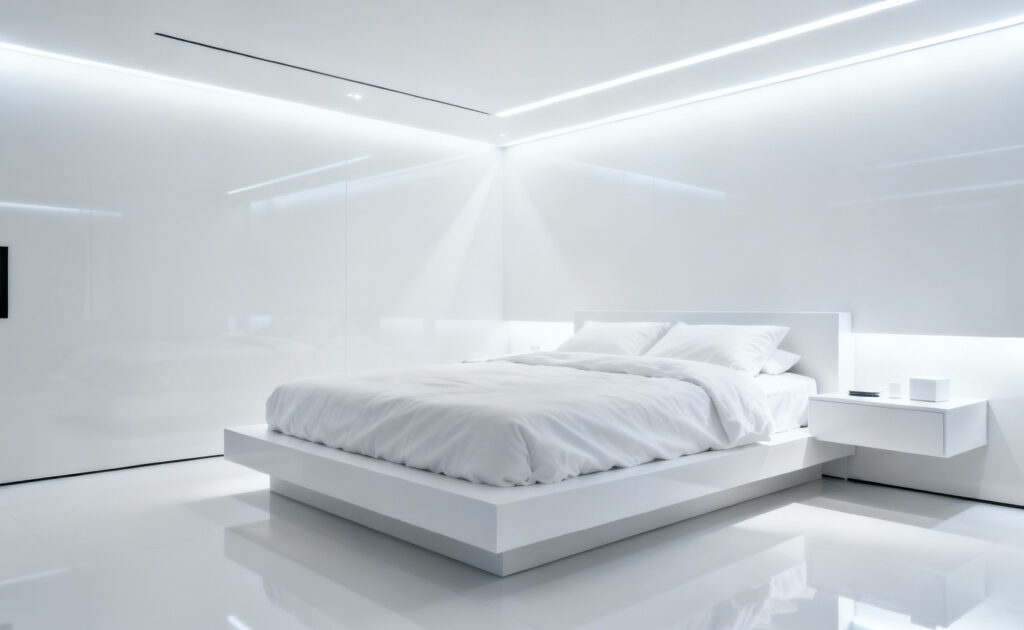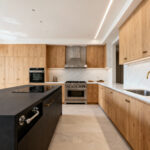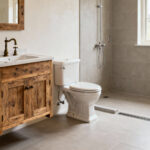When executed correctly, white bedroom decor transcends the “safe” absence of color to become the most sophisticated hue in the spectrum. Early in my design career, a client confessed that her freshly painted “neutral” bedroom made her feel anxious and cold rather than relaxed. Walking in, the reason for her distress was scientifically obvious: she had plastered a north-facing room in a stark, blue-based white. Her sanctuary didn’t need less color; it needed the right psychological foundation.
White acts as a mirror, reflecting and amplifying the energy of its environment. Consequently, the subtle undertone—whether the yellow of a warm embrace or the blue of a crisp morning—becomes the room’s dominant force. Understanding this interaction moves beyond aesthetics; it defines the mood that greets you when you wake and the energy that settles you before sleep. You aren’t just picking a paint chip; you are shaping your daily experience.
This guide bridges the gap between artistic intuition and optical science. We will decode the mystery of undertones, analyze how window direction dictates your palette, and learn to layer textures to banish the “clinical” look forever. By the end, you will possess the confidence to stop guessing and start designing a white bedroom that truly restores you.
Achieving Serenity with White Bedroom Decor
Absolute white creates an illusion of cleanliness, but psychologically, it often backfires. We call this the “Clinical Effect.” Pure white’s high light reflectivity mimics sterile environments like laboratories, subconsciously triggering alertness when you need sleep. A stark white bedroom often feels less like a sanctuary and more like a waiting room. To cultivate true relaxation, you must look beyond the can of “ultra-bright” and embrace the complexity of nuanced off-whites.
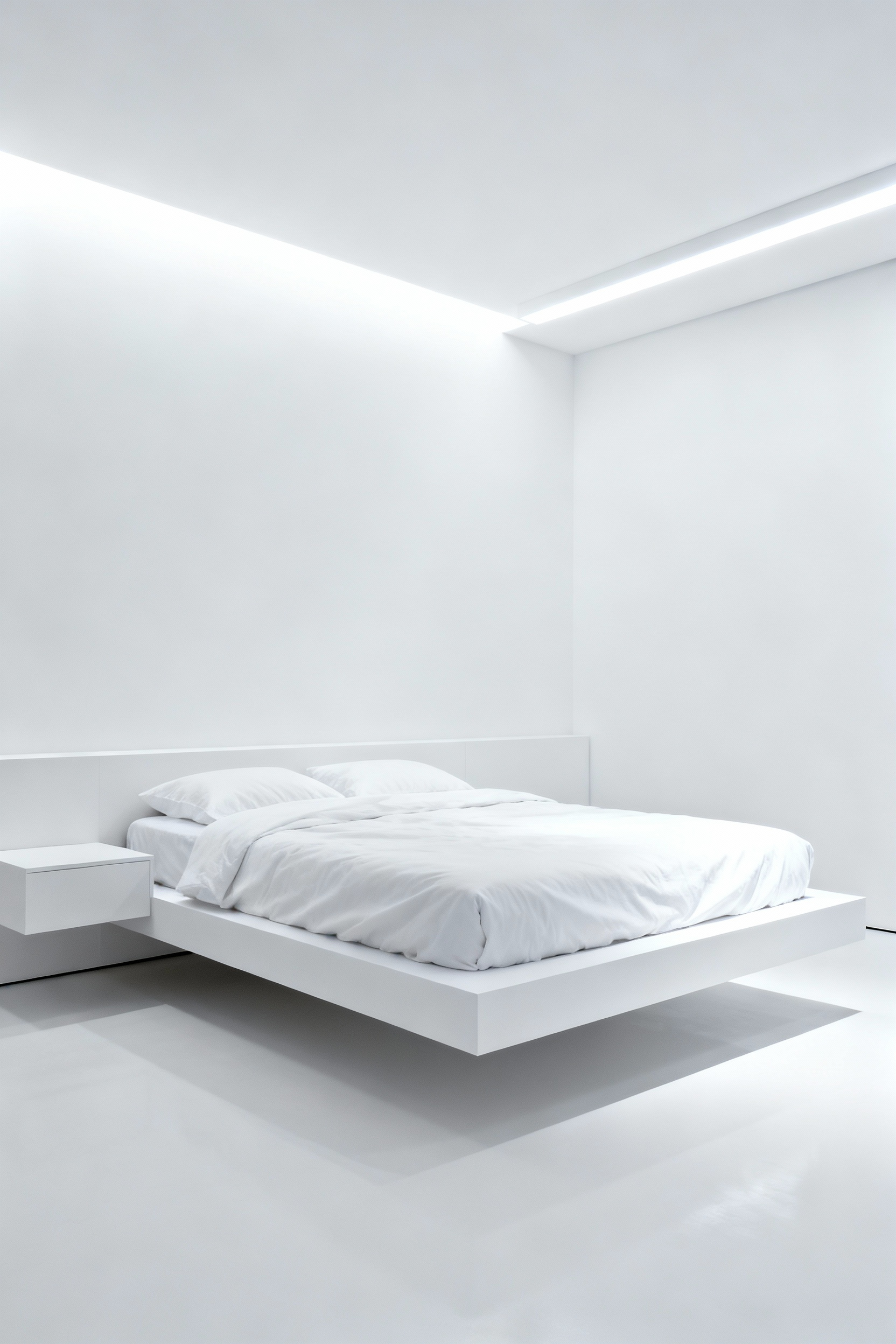
Shift the energy from sterile to serene by manipulating undertones and texture. First, choose complex whites with hints of cream, beige, or blush to soften the light and create a protective “cocoon” atmosphere. Second, reserve bright white strictly for trim or cabinetry to maintain clarity without overwhelming the senses. Finally, layer organic textures—think chunky knit throws, linen bedding, and light wood—to replace the visual void with tactile depth. This approach ensures your room feels restorative, not sparse.
Undertone Psychology 101
True white is an illusion. Every paint contains a hidden base—yellow, blue, or red—that acts as a psychological thermostat for your bedroom. To reveal this secret identity, compare your swatch against pure printer paper or examine the darkest hue on the paint strip. Suddenly, the “invisible” green or violet undertone becomes undeniable. In psychology-focused design, this data is used to counterbalance a room’s natural light bias and actively manipulate the occupant’s mood.
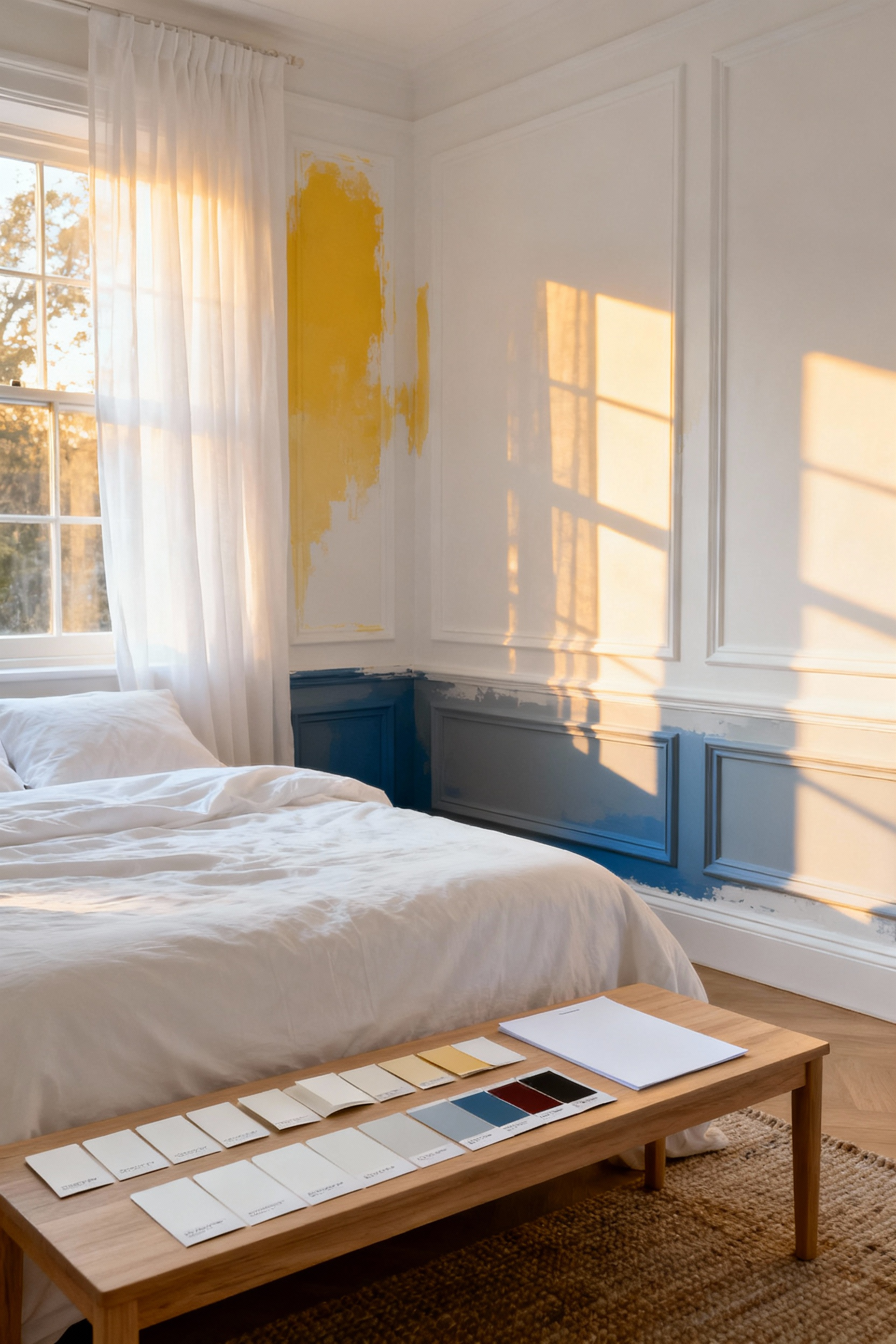
Strategically oppose the light source to control the environment. A North-facing room inevitably casts a gray, cool shadow; fight this by selecting a white with a yellow or red base. This trick simulates sunshine and prevents a clinical feel. Conversely, subdue the overwhelming brightness of a South-facing window with a blue-based white, creating a crisp, soothing sanctuary. For a softer alternative to yellow, I strongly recommend whites with a delicate pink undertone; they flatter the complexion and radiate a cozy warmth without the brassiness of gold.
The North vs. South Light Rule
Light physics directly dictates your emotional response to a room. In North-facing bedrooms, natural light leans cool and blue, often causing standard white paint to read as a depressing, muddy gray. I frequently advise clients to “trick the eye” here by selecting whites with warm yellow or pink undertones. This pigment counterbalance mimics sunlight, instantly preventing the space from feeling sterile and creating a cozy psychological sanctuary.
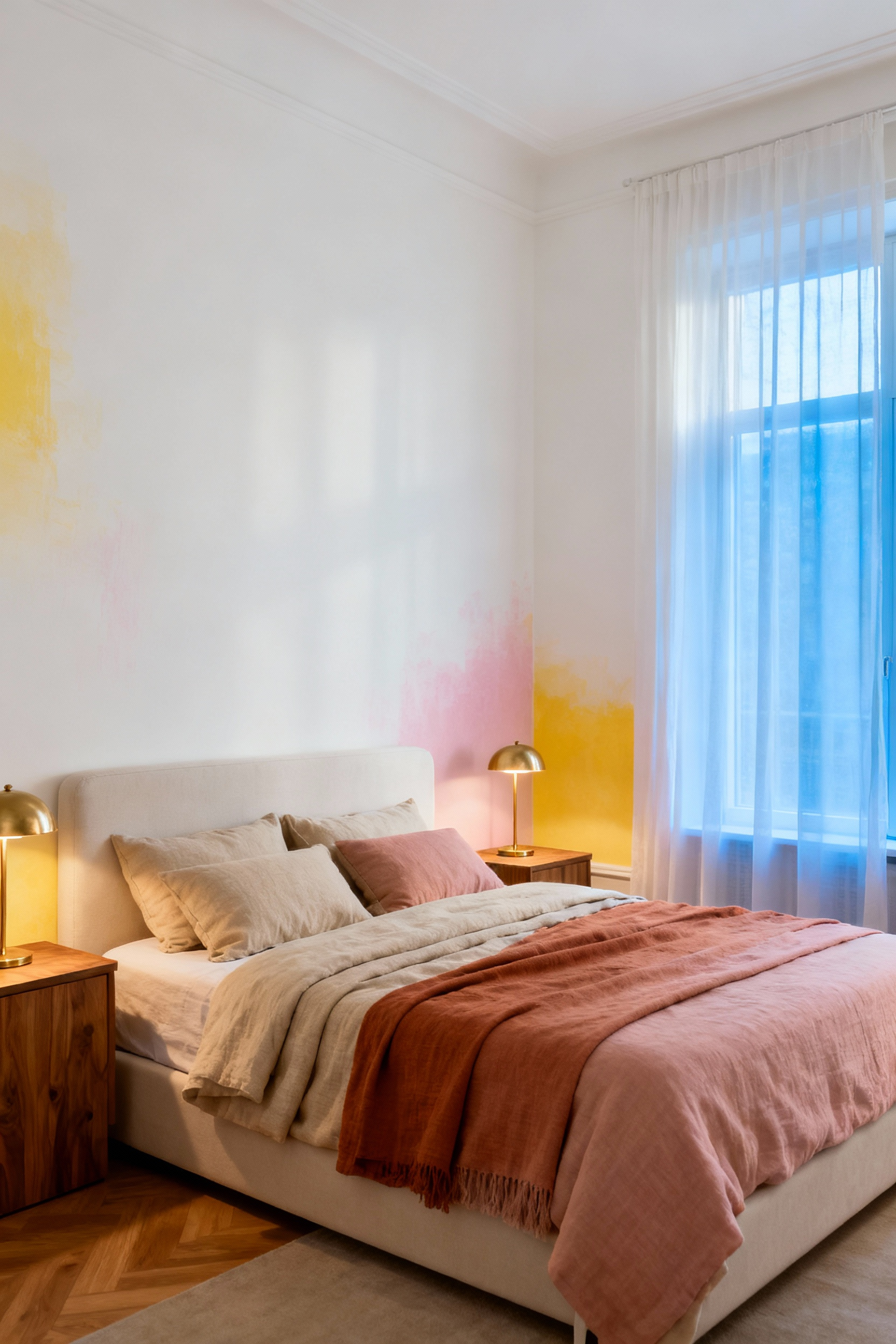
Conversely, Southern exposure floods your walls with intense, golden warmth. A yellow-based white in this environment often feels suffocatingly bright or “blinding.” To maintain sophistication and visual equilibrium, apply the law of opposites:
- For North Light: Use warm undertones to inject life and energy.
- For South Light: Use cool undertones (gray, blue) to neutralize glare.
Finally, never skip the swatch test. Paint chemistry interacts dynamically with changing light, so observe your samples morning, noon, and night. Understanding these shifts prevents regret and ensures your bedroom remains a place of rest rather than visual agitation.
Texture as the New Pigment
When you eliminate color, you remove the eye’s primary source of stimulation. The brain then searches for other sensory inputs to map the space. If a white room lacks tactile variety, it registers as clinical and sterile rather than calm. Therefore, you must treat texture as a physical pigment. By layering opposing surfaces, you manipulate how light plays across the room. Smooth, sateen finishes reflect morning light to energize, while rough, nubby wools absorb it to create intimate, grounding shadows at night.
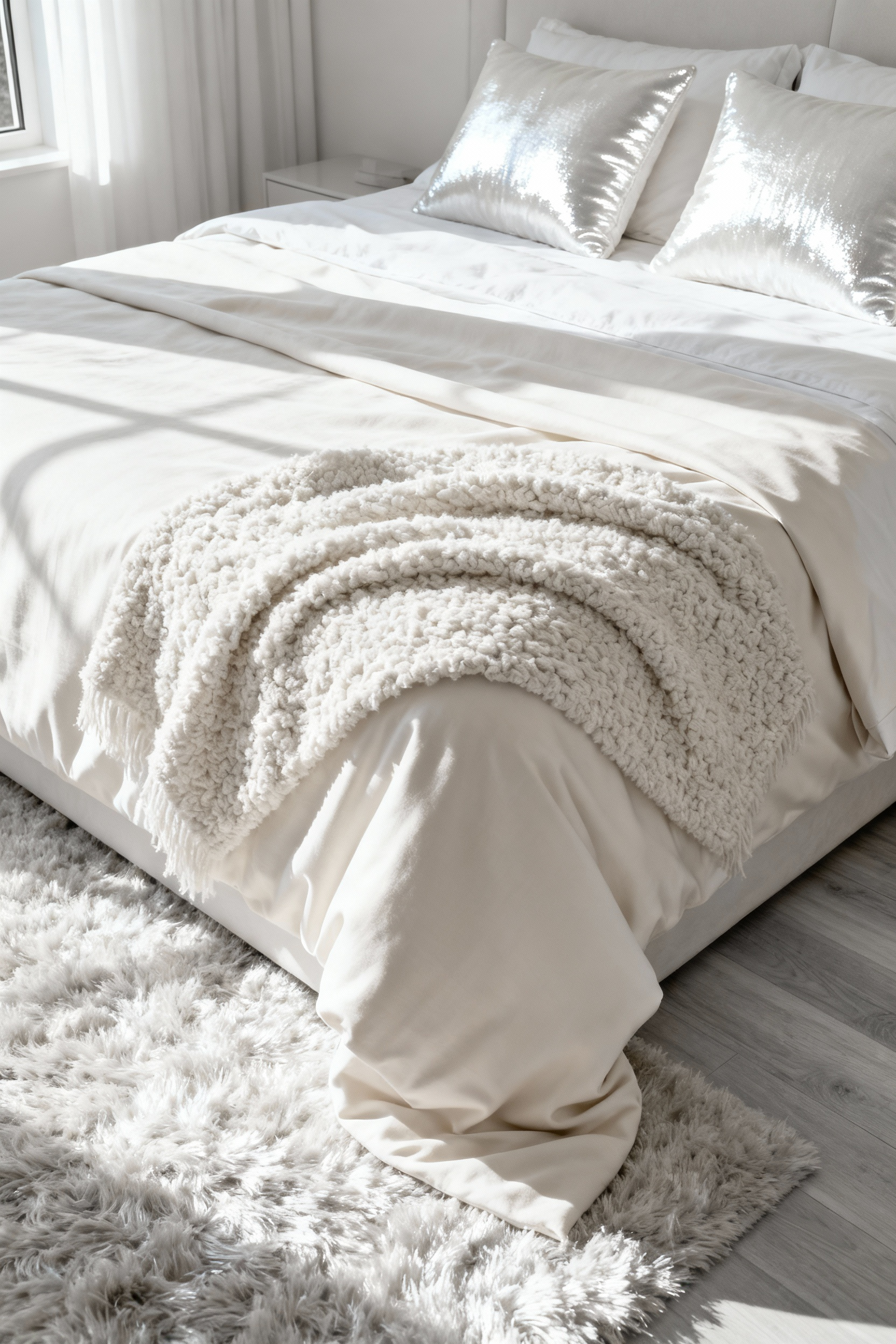
Tactile contrast is essential for emotional regulation. A flat room creates cognitive boredom, but rich textures induce comfort. To master this, focus on material opposition:
- Anchor the space with a light-absorbing deep-pile rug to prevent the room from feeling weightless.
- Layer the bed by pairing cool, breathable linen sheets with heavy, luxurious velvet pillows.
- Disrupt the softness using raw oak nightstands or unpolished ceramic lamps.
This strategic friction between materials maintains sensory engagement, ensuring your sanctuary feels sophisticated instead of empty.
The Science of Sheen
Your brain interprets strong light reflection as visual noise, often triggering alertness rather than relaxation. To engineer a true sanctuary, coat your main walls in matte or flat white paint. This finish absorbs glare and diffuses illumination, effectively signaling your nervous system to power down. Clients consistently report deeper rest in rooms that minimize light bounce. Additionally, matte paint offers a practical advantage: it creates a forgiving canvas that camouflages minor wall imperfections better than higher sheens.
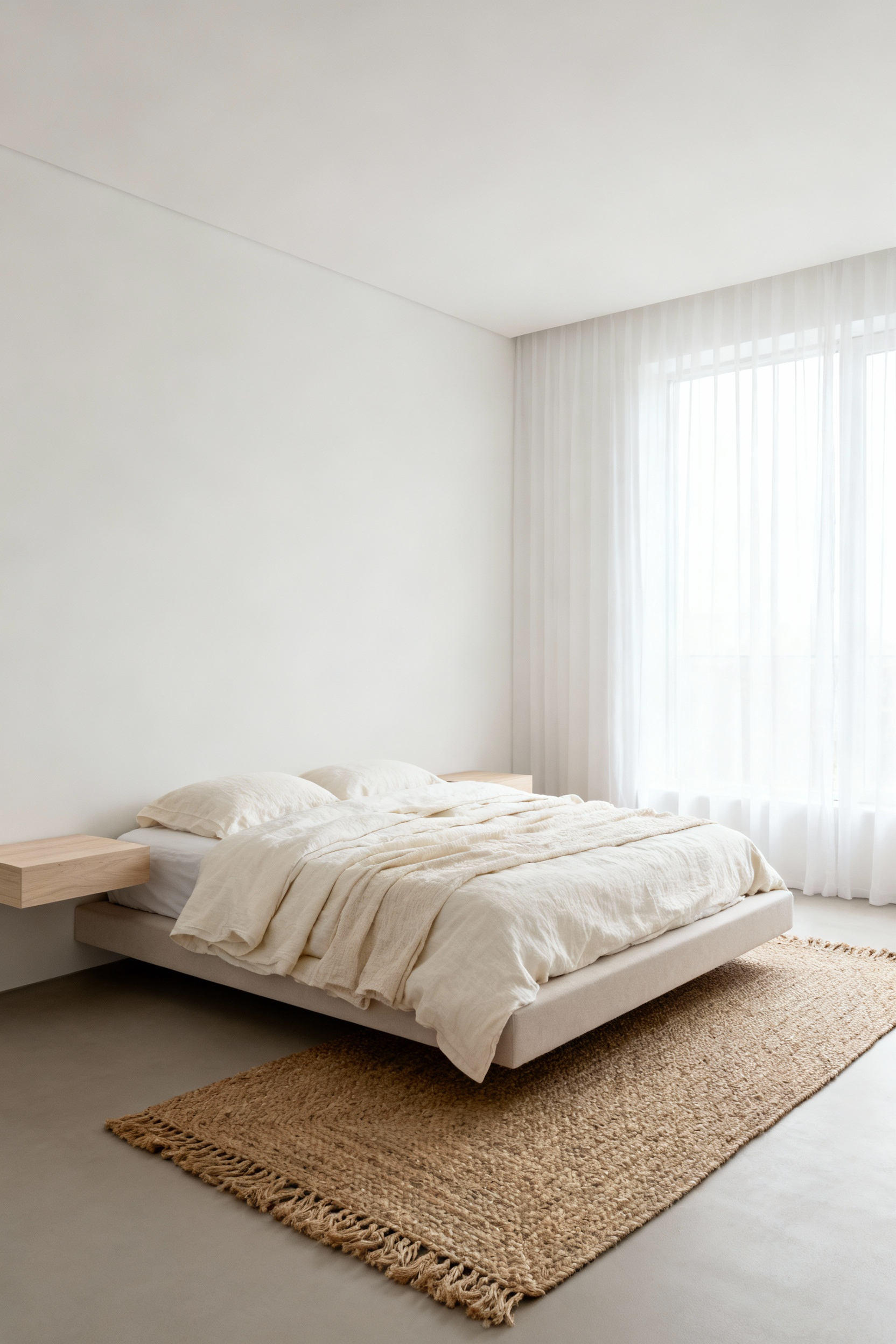
Conversely, a room without reflection risks feeling stagnant. To inject vitality, contrast those soothing matte walls with strategic high-gloss accents. A lacquered nightstand or semi-gloss trim acts like a mirror, bouncing light to expand the space and add a modern, energetic sparkle. Master this balance with a layered approach:
- Define: Use semi-gloss on molding to sharpen architectural lines against soft walls.
- Energize: Paint a single focal point, like a door, in high-gloss for a vibrant lift.
- Ground: Offset shiny surfaces with matte textures like wool or linen bedding to prevent a clinical look.
This deliberate tension between absorbing and reflecting light transforms a white bedroom from simple to sophisticated.
Layering ‘Invisible’ Colors
Perfection is the enemy of depth in monochromatic spaces. When you strictly color-match every white surface, you create a sterile environment that the brain interprets as clinical rather than serene. To counter this, embrace the subtle friction between undertones. Contrast warm alabasters and rich creams against cool, crisp linens to force the eye to travel around the room. This variance signals organic comfort to the subconscious, preventing the flatness that makes a room feel “staged.”
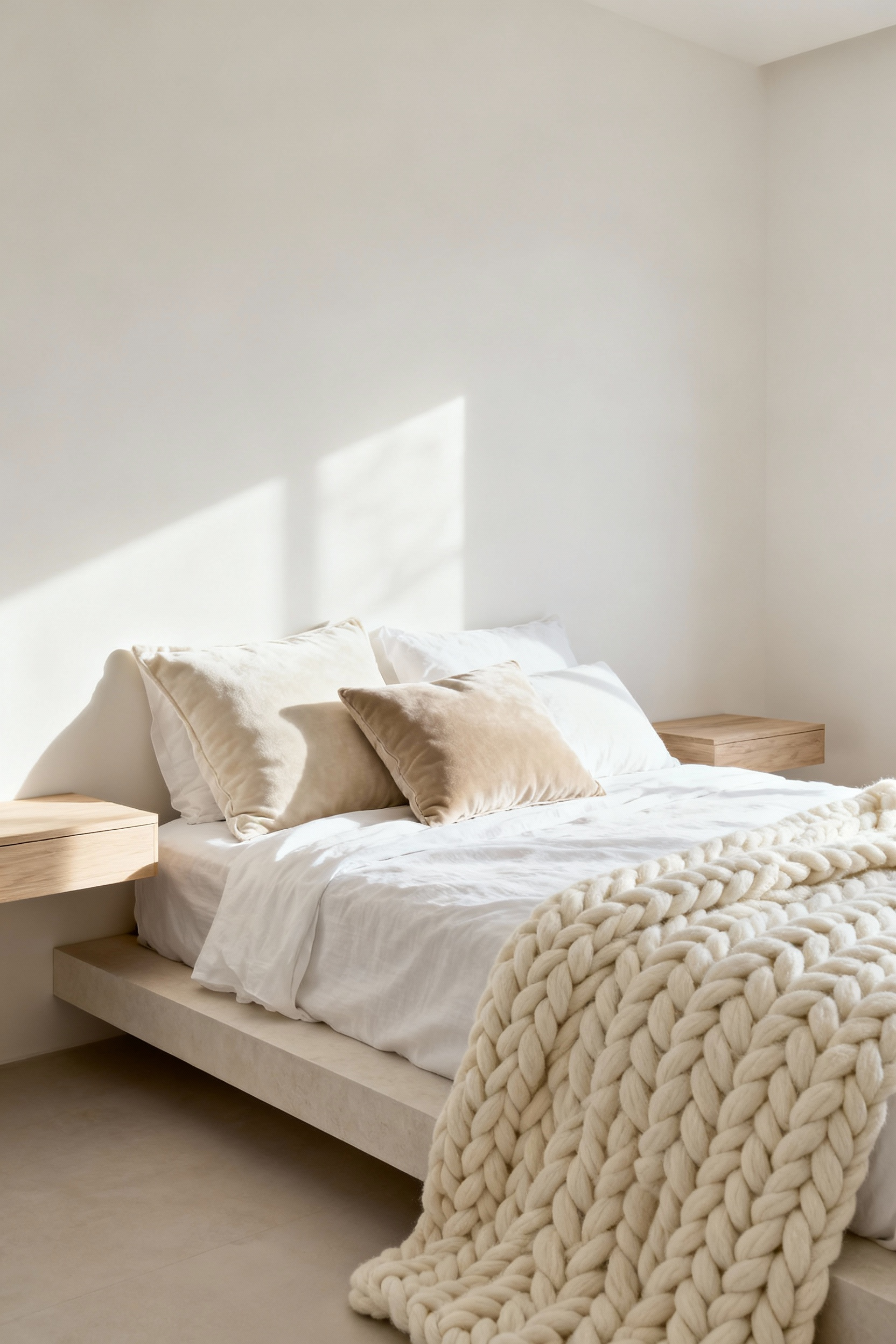
To successfully layer these “invisible” colors, you must treat texture as a color value. Since hue differences are minimal, tactile variation creates the necessary boundaries between layers.
- Anchor with Crispness: Use pure white on trim or baseboards to act as a palette cleanser, ensuring creamier tones look intentional rather than dirty.
- Diversify Materials: Place a nubby bouclé chair in bone next to smooth cotton sheets to visually separate the shades.
Always test these combinations under your specific natural light, as exposure shifts undertones dramatically.
The Wooden Grounding Rod
An all-white bedroom often feels ethereal, yet without visual weight, it risks becoming unmoored and clinical. Our brains crave stability, and a total lack of contrast signals spatial uncertainty. To combat this “floating” sensation, deploy a “Wooden Grounding Rod”—a single, substantial timber element that forcefully pulls the eye downward. Introducing a heavy walnut bed frame or a raw oak floor to a monochrome space acts as a visual anchor, providing the necessary gravity to make the room feel psychologically safe.
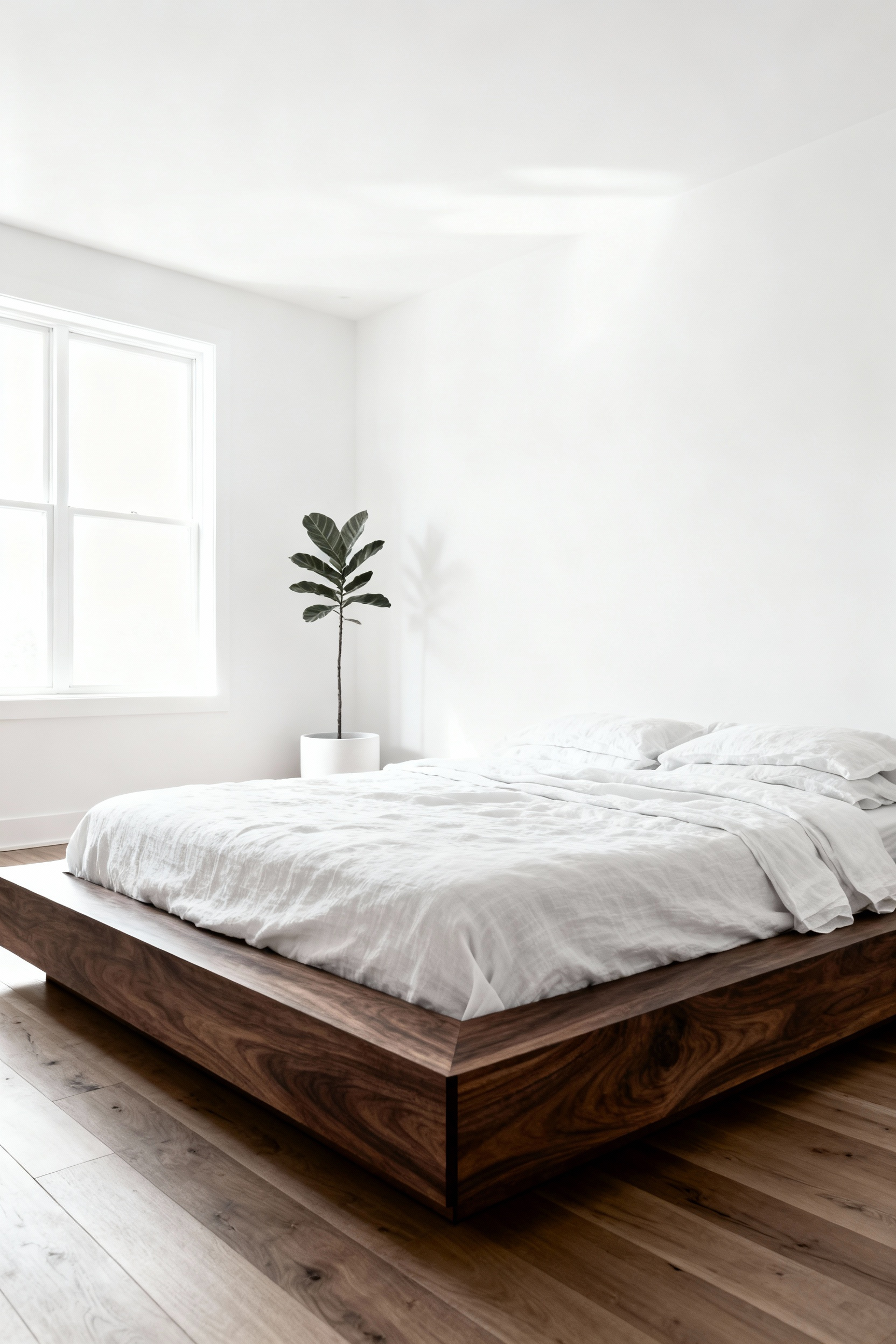
This technique leverages biophilic texture to deepen the sensory experience. Since smooth white paint offers zero tactile feedback, you must layer in organic imperfections to lower cortisol levels and invite touch. Apply these principles to effectively stabilize your sanctuary:
- Select visible grain: Choose timber with knots or deep grain to physically disrupt the sterile flatness of the walls.
- Define the horizon: Use a low, dark wood dresser or bench to create a strong horizontal line near the floor, delineating “earth” from “sky.”
- Match undertones: Pair natural timber with warm, creamy whites rather than icy cool tones to bridge the gap between starkness and comfort.
These wooden touches transform a space from a cold gallery into a restorative retreat.
The 5% Black Rule
Our eyes crave contrast to understand physical space. Without it, an all-white room feels less like a sanctuary and more like a boundless void. This missing element is “visual punctuation.” Just as a period stops a sentence, a touch of true black stops the eye. It provides a necessary resting place within the brightness, allowing the brain to register depth and stability. The 5% Black Rule introduces just enough visual weight to ground the room without darkening its airy atmosphere.
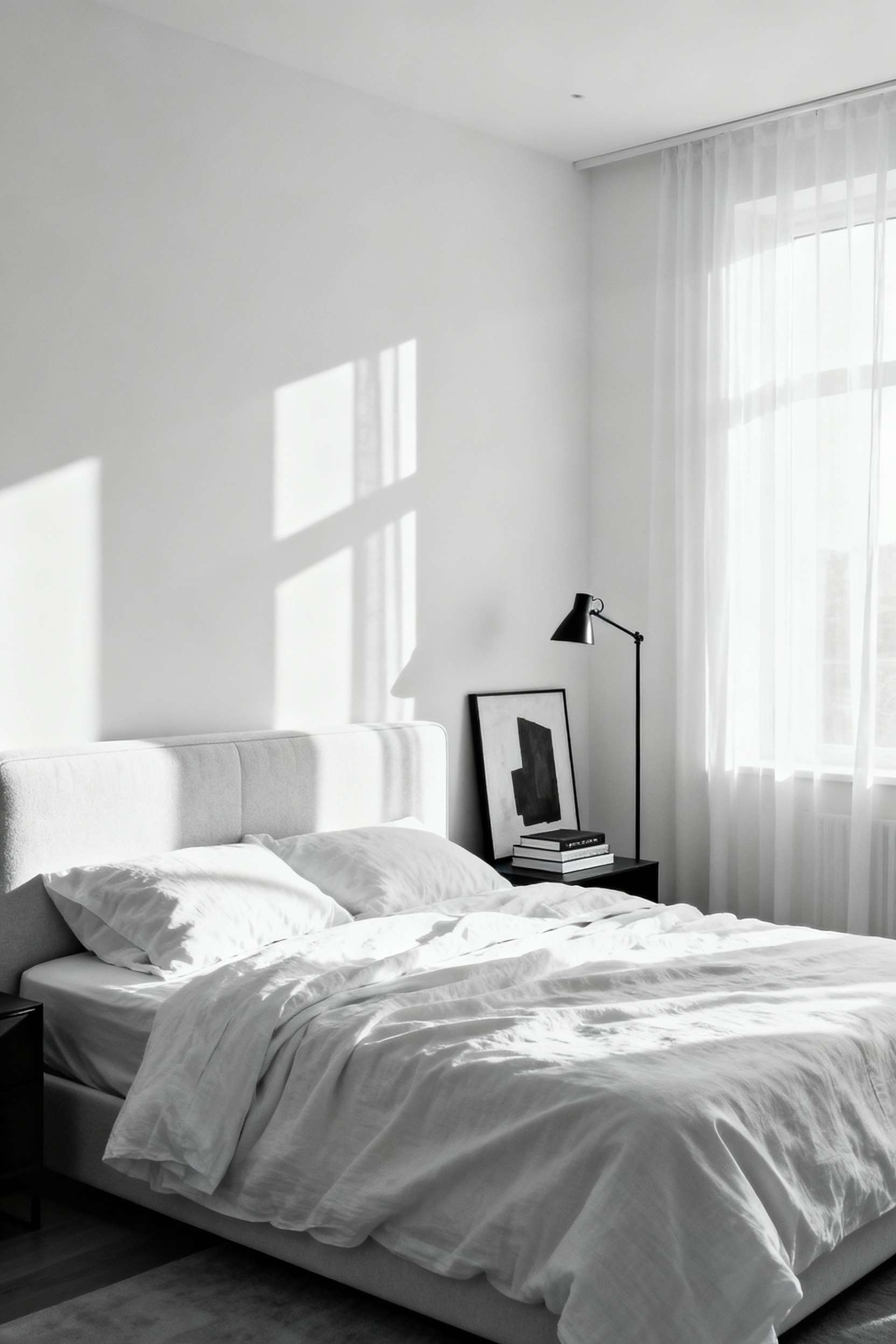
Apply this principle with surgical precision to create a sophisticated, tailored finish. You do not need heavy furniture; you need sharp definition. Start by replacing standard hardware with matte black drawer pulls to create crisp boundaries against soft white surfaces. Then, establish a cohesive flow by repeating the color in three distinct zones:
- Anchor the focal point: Place sleek black lamps or a metal bed frame centrally to prevent the room from feeling weightless.
- Frame the perimeter: Install a slim black curtain rod or door handle to define the room’s edges.
- Connect the details: Add a black-rimmed clock or a patterned pillow to guide the gaze across the space.
These high-contrast anchors transform a monotonous blur into a deliberate, harmonious environment.
Kelvin Temperature Mastery
Pure white decor demands precise light management to function correctly. Standard 2700K bulbs often cast a heavy, orange hue on crisp white walls, instantly turning a serene aesthetic into something that feels dingy or unintentional. To preserve the psychological clarity of your space while respecting your circadian rhythm, separate your lighting layers. Swap your main overhead fixtures to 3000K Soft White bulbs; this temperature retains the clean integrity of your palette without the sterility of office lighting.
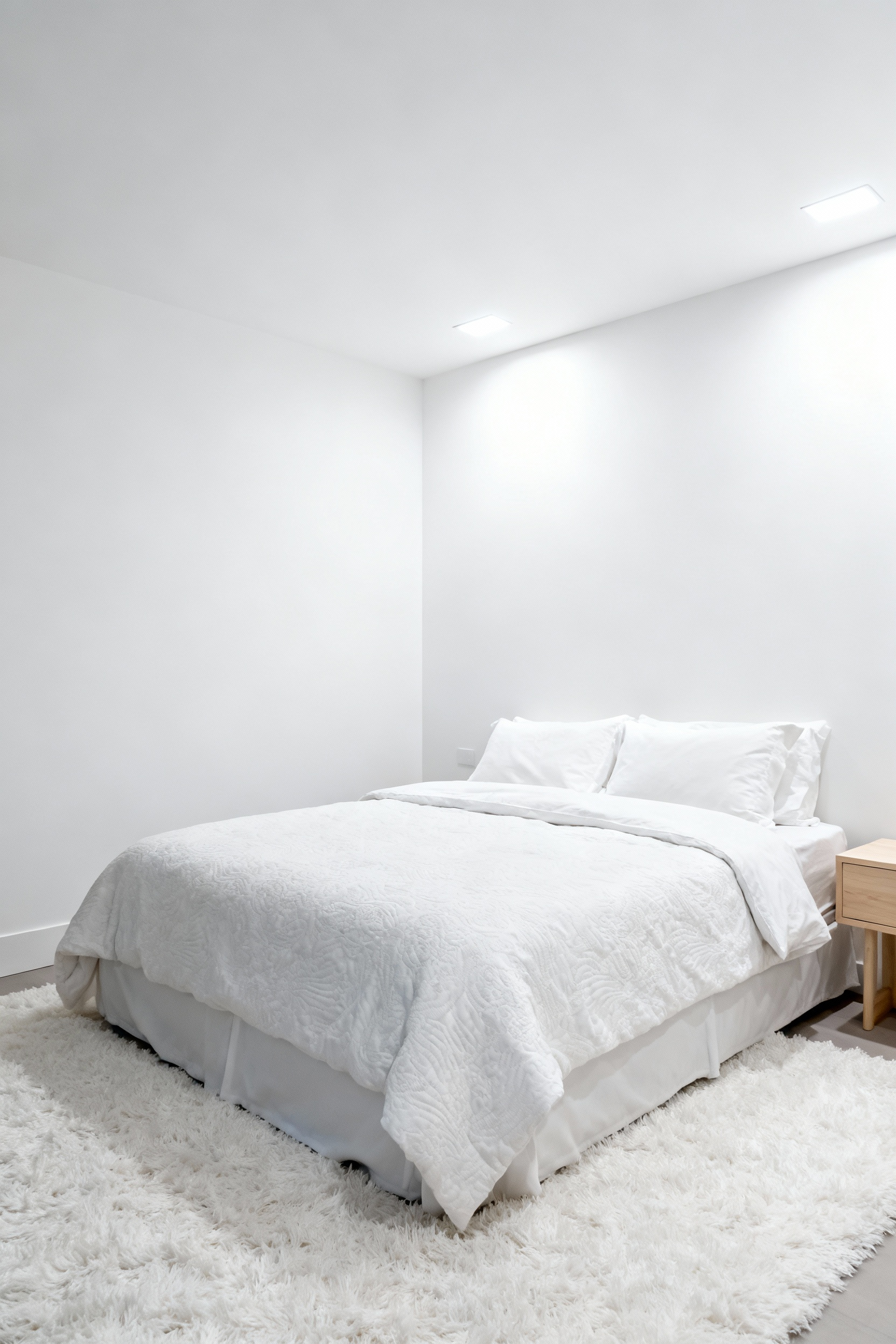
However, biology still craves warmth before sleep. The best emotional balance is achieved through a tiered lighting strategy:
- General Ambience: Use tunable smart bulbs set to a crisp 3000K for early evening energy.
- Task/Relaxation: Restrict deep, warm amber tones (2200K–2700K) exclusively to bedside lamps.
This separation solves the conflict between aesthetics and function. You maintain the visual expanse of your white room during active hours, yet you still receive the hormonal cue for rest when you switch to bedside lighting. By treating light temperature as a design tool rather than an afterthought, you ensure your environment supports both your style and your sleep.
Architectural Shadow Play
A purely white room risks feeling like a clinical void. Without visual anchors, the human brain struggles to gauge depth, creating a subtle sense of unease known as visual fatigue. Architectural molding solves this psychological puzzle by manipulating light itself. By painting your wainscoting and walls the exact same shade of white, you force the structure to create the necessary contrast. The sun becomes your secondary painter, casting shifting grey shadows that break up the monotony without adding visual clutter.
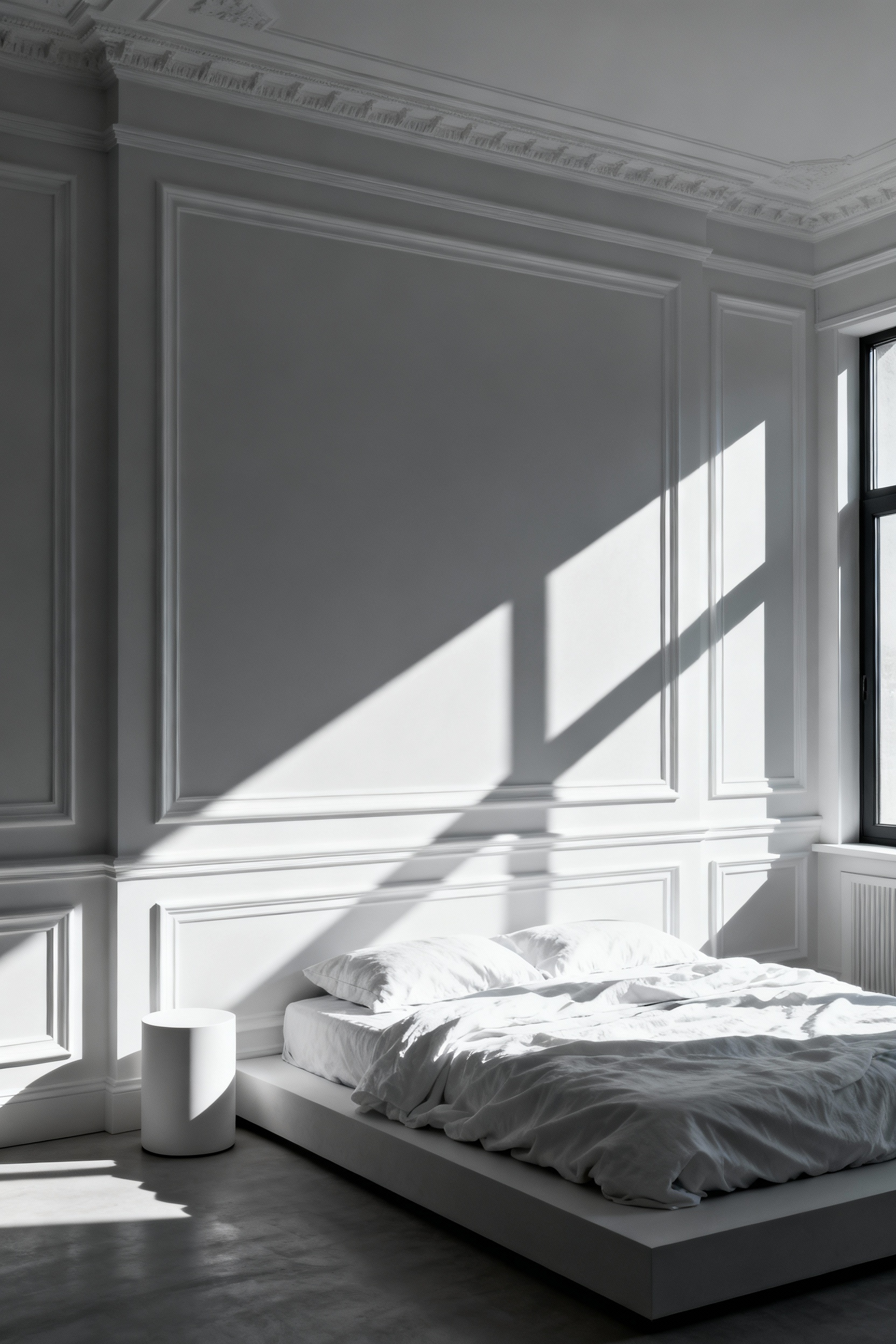
To maximize this effect, position your molding on walls receiving direct natural light. The sun’s angle determines the intensity of the “grey,” shifting the room’s energy from sharp and awakening in the morning to soft and moody at dusk. Select a profile that shapes your desired atmosphere:
- Board and Batten: Casts long, vertical shadows that psychologically lift the ceiling, making the room feel expansive.
- Picture Frame Molding: Creates rhythmic, boxed shadows for a sense of traditional order and stability.
- Shiplap: Produces clean horizontal lines that visually widen the space.
Finally, soften these sharp architectural lines with tactile linen or chunky knit throws. This textural balance prevents the space from feeling cold, ensuring the white environment remains soothing rather than stark.
The Bed as a Cloudscape
Transforming your bed into a “cloudscape” does more than look luxurious; it fundamentally alters your brain chemistry for restorative rest. The psychology here is rooted in the “Cocoon Effect,” where high-loft layers provide a subconscious sense of security that lowers cortisol. An all-white palette clears mental clutter, but you must vary textures to prevent sterility. Visual silence shouldn’t feel cold.
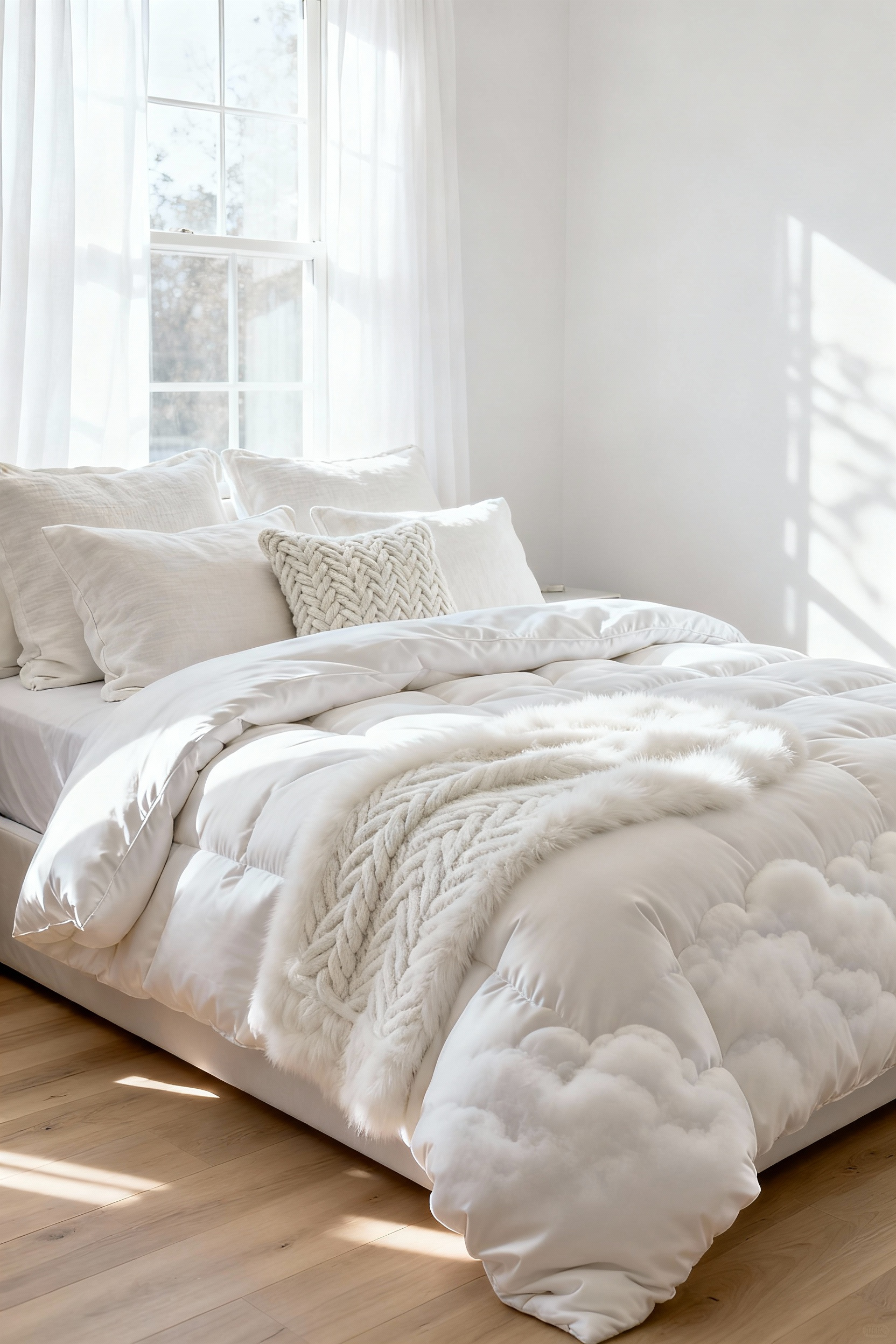
To build this sleep sanctuary, follow this three-step layering technique:
- Base: Start with breathable, crisp cotton or bamboo sheets to regulate temperature and prevent micro-awakenings during vital REM cycles.
- Loft: Add a plush, mid-weight duvet insert to create that essential, airy volume.
- Texture: Anchor the look with a chunky knit or faux fur throw in ivory at the foot of the bed.
This combination adds depth without visual noise. The gentle weight mimics a hug, signaling your brain that it is safe to drift into deep sleep.
Strategic Reflection
In a white bedroom, light acts as a potent stimulant; unmanaged reflections can quickly turn a sanctuary into a source of visual fatigue. To harness luminosity without the stress of glare, avoid placing mirrors directly opposite windows. Instead, mount them on perpendicular walls to intercept sunlight and wash it sideways, effectively softening the room’s energy. Mistaking “brightness” for “harshness” creates high-contrast glare that triggers a subconscious alertness and spikes cortisol levels.
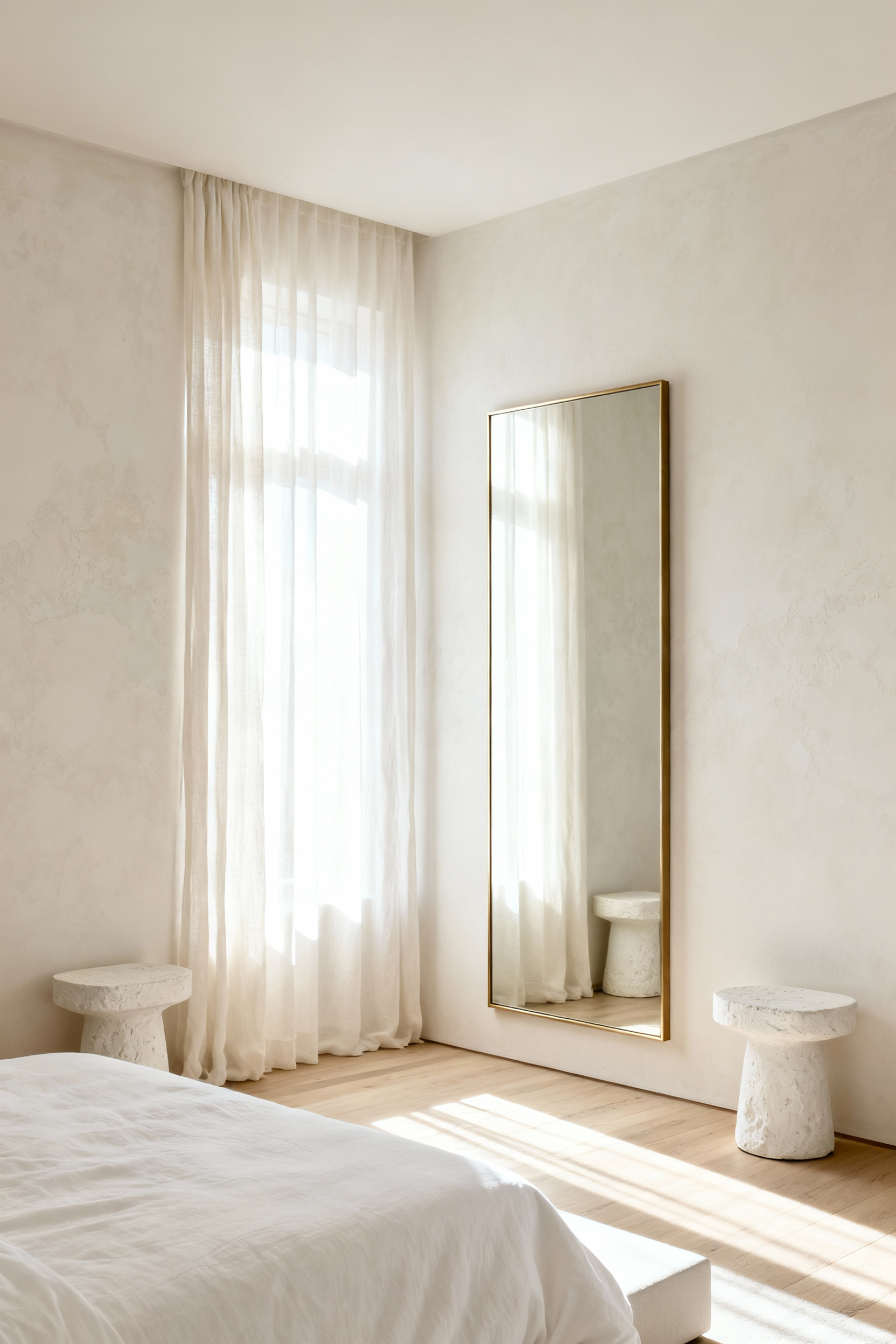
Correct this imbalance by prioritizing diffusion over direct reflection:
- Choose beveled or segmented styles to physically scatter intense light beams.
- Target neutral surfaces like the ceiling for reflections, keeping light away from the bed.
- Backlight bedside lamps with small mirrors to amplify warm, evening ambience.
Never hang a mirror facing the bed. The brain registers moving reflections as low-level threats, disrupting the winding-down process. By angling light strategically, you create a space that feels expansive yet psychologically safe.
Metal Metaphors
In a monochromatic white space, metals function less like hardware and more like emotional thermostats. The absence of wall color forces the eye to analyze texture and reflectivity, drastically amplifying the inherent temperature of your fixtures. Select brass or copper to inject a “solar” quality; these warm metals counteract potential sterility and trigger subconscious feelings of cozy safety. Conversely, utilize chrome or stainless steel to lower the visual temperature. These cool, reflective surfaces sharpen the room’s lines, bounce light to expand the space, and promote a sense of crisp, modern alertness.

We physically react to these visual temperatures, seeking warmth for comfort or coolness for clarity. Treat hardware like jewelry, using small details to shift the mood. To master this thermal balance:
- Select Polished Finishes like gleaming brass or chrome for high-energy reflection and glamour.
- Choose Brushed Finishes to mute the impact, adding a quiet, tactile depth that feels more transitional.
- Mix Temperatures by pairing a dominant warm metal with subtle cool accents to prevent the room from feeling one-dimensional.
Biophilic Pops
An all-white bedroom risks feeling clinical, yet the solution isn’t paint; it is life. Biophilic design dictates that our brains crave organic connection to reduce anxiety. Deep green foliage acts as a psychological anchor against a stark white backdrop, transforming a sterile space into a restorative sanctuary. Introducing these “biophilic pops” quiets mental noise and immediately signals safety to the primitive brain.
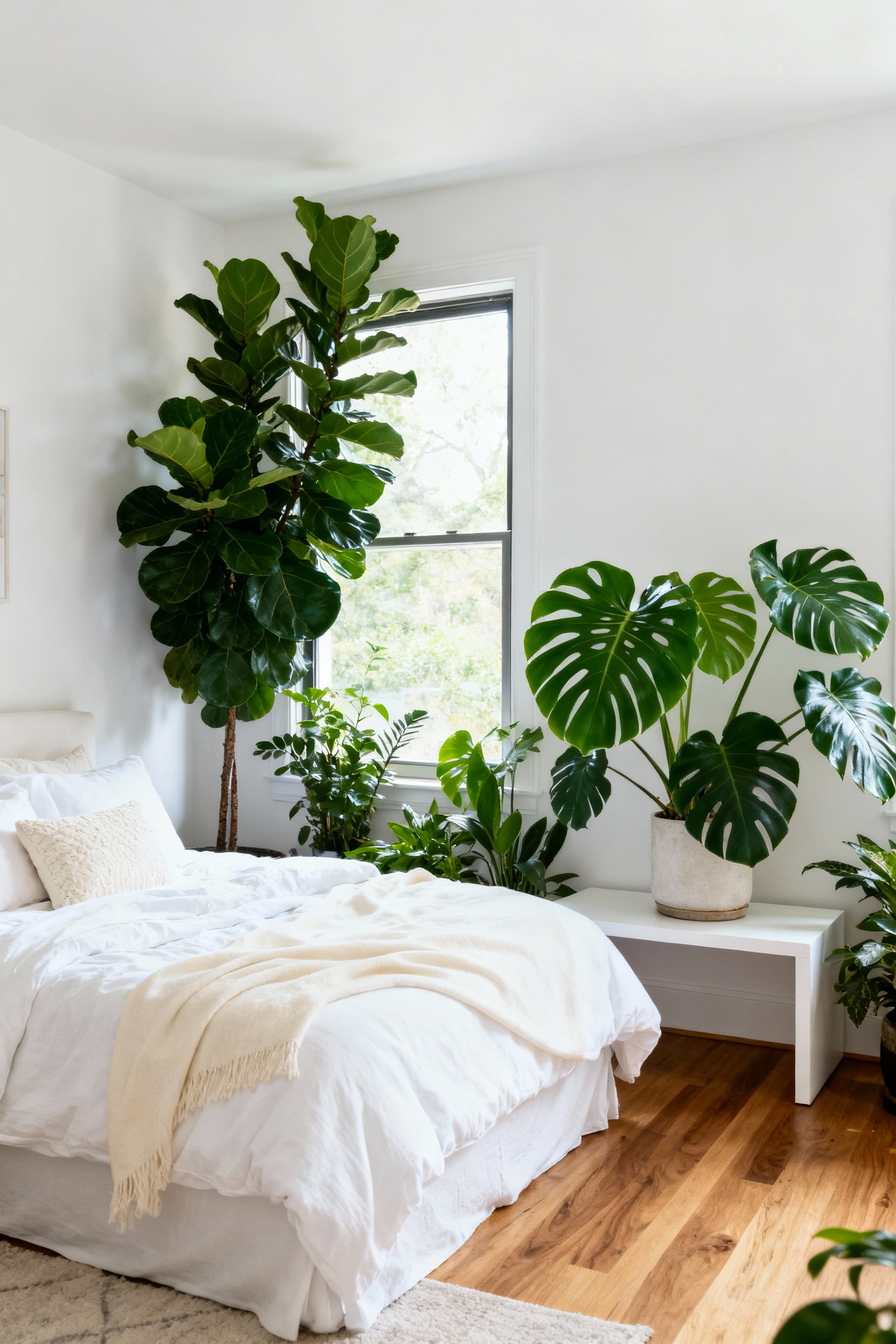
To cultivate this calm without adding stress, prioritize functionality and air purity. Select robust, air-scrubbing varieties that thrive in low-light bedroom corners:
- Snake Plants (Sansevieria) for vertical structure and unique nighttime oxygen release.
- Pothos for trailing vines that soften rigid architectural lines.
- Peace Lilies to filter airborne toxins like benzene.
House these botanicals in planters made of rattan, wood, or stone. These natural textures warm the white palette, ensuring your room feels curated rather than cluttered.
The Art of Negative Space
Treat your white walls as active design elements rather than empty voids awaiting filler. Visual clutter triggers subconscious stress, preventing the brain from achieving true relaxation. You must protect your room’s “breathing room.” Instead of scattering small items across every surface, prioritize a single, high-impact anchor piece above the bed. Ideally, this artwork should span two-thirds to three-fourths of the headboard’s width, grounding the room confidently without creating cognitive fatigue.

If you prefer variety over a single statement piece, apply these rules of intentional restraint to maintain serenity:
- Embrace line art: Use simple, tone-on-tone sketches or geometric shapes to create depth through form rather than heavy color.
- Curate gallery walls: Keep groupings small, maintain consistent framing, and leave ample empty wall space around the collection.
- Let texture lead: Swap flat images for macramé or textured canvas to add warmth without adding visual weight.
By allowing the white wall to actively surround your art, you transform empty space into a calming, sophisticated frame that enhances your wellbeing.
Seasonal White Transitioning
White walls naturally reflect light, stimulating alertness and creating the airy atmosphere we crave in July. However, as circadian rhythms shift in winter, the brain instinctively seeks enclosure and safety. You can satisfy this psychological need without opening a paint can by manipulating tactile feedback. Replace breathable, stark white linens with high-density fabrics like brushed cotton or velvet in warmer ivory tones. These heavy materials absorb rather than deflect sound and light, instantly quieting the room’s energy and increasing perceived warmth.
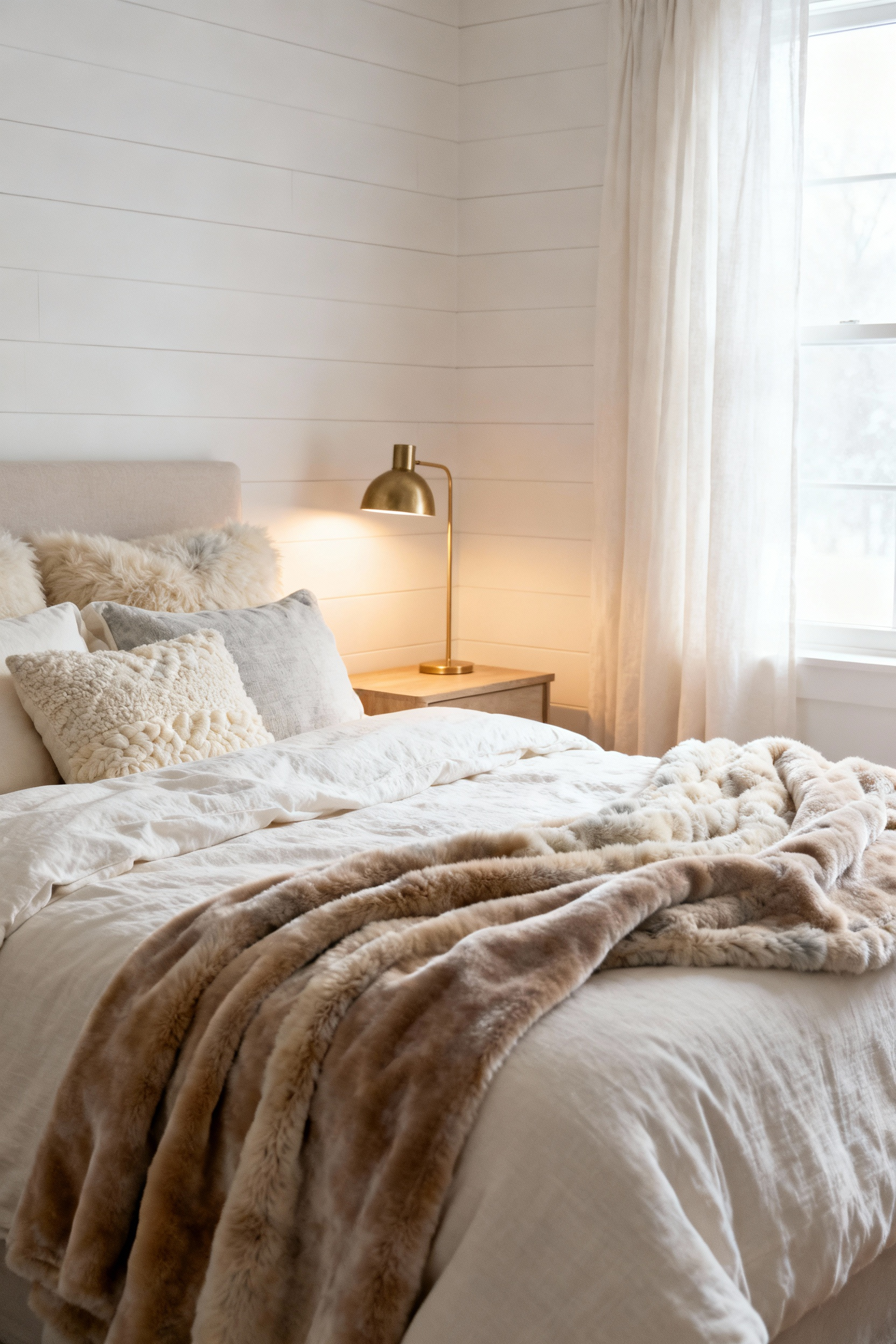
“Cozy” is simply a measure of visual complexity and contrast. To achieve this, prioritize depth over surface area. Implement these strategic shifts to ground the space:
- Anchor the bed with a weighted, chunky knit or faux fur throw.
- Introduce visual weight through plush rugs or pillows in deep earth tones like rust or charcoal.
- Shift the spectrum by swapping cool bulbs for warm 2700K options.
The walls will reflect a golden glow rather than a blue tint, effectively transforming your crisp summer sanctuary into a restorative winter cocoon.
Frequently Asked Questions about White Bedroom Decor
What is the best shade of white paint for a bedroom?
The “best” shade depends heavily on your room’s natural light exposure. For north-facing rooms (which receive cool, blue light), choose a warm white with subtle yellow, pink, or red undertones (like Alabaster or Creamy White) to prevent the walls from looking cold and gray. For south-facing rooms (which receive bright, warm light), select a neutral or cool white with a touch of gray or blue undertone to neutralize the glare and maintain a crisp look.
How do I keep an all-white bedroom from looking sterile or clinical?
To prevent an all-white space from feeling clinical, focus entirely on layering tactile materials and textures. Incorporate elements like chunky wool throws, matte linen bedding, wicker baskets, raw wood furniture, and deep-pile rugs. The friction between these opposing textures (smooth metal vs. rough wood; soft velvet vs. crisp cotton) creates visual depth and sensory engagement, making the room feel luxurious and cozy rather than sparse.
What colors should I use to accent white bedroom decor?
If you want to maintain a restful, monochromatic feel, introduce deep green foliage (biophilic pops) and small elements of matte black (following the 5% Black Rule) to provide contrast and grounding. If you desire color, look to nature-inspired neutrals like deep sage, terracotta, or muted charcoal gray, as these colors provide sophisticated contrast without becoming overly stimulating or detracting from the inherent tranquility of the white space.
Conclusion
Choosing a monochromatic white palette is not a surrender of imagination; it is a sophisticated strategy for mental hygiene. By deliberately reducing visual noise, you grant your brain the permission it needs to stop processing and start resting. This chromatic restraint turns your bedroom into a psychological sanctuary, offering a necessary counter-balance to a chaotic world.
To execute this look effectively, prioritize depth over variety. Avoid sterile, cold tones and instead layer warm creams, tactile linens, and grounding wood elements to build a space that feels soulful rather than empty. Let texture provide the interest that color usually demands. If you crave contrast, use restraint; a single, muted accent or a live plant can anchor the room without breaking its tranquility.
Ultimately, design is about how a space feels, not just how it looks. Embrace the quiet confidence of white to reclaim your energy and focus. Assess your current environment today and consider stripping back the excess. Dare to choose simplicity in your white bedroom decor, not for what it removes from your room, but for the clarity it restores to your mind.
